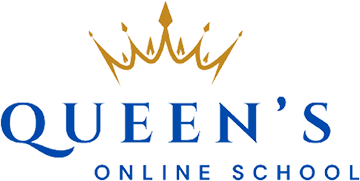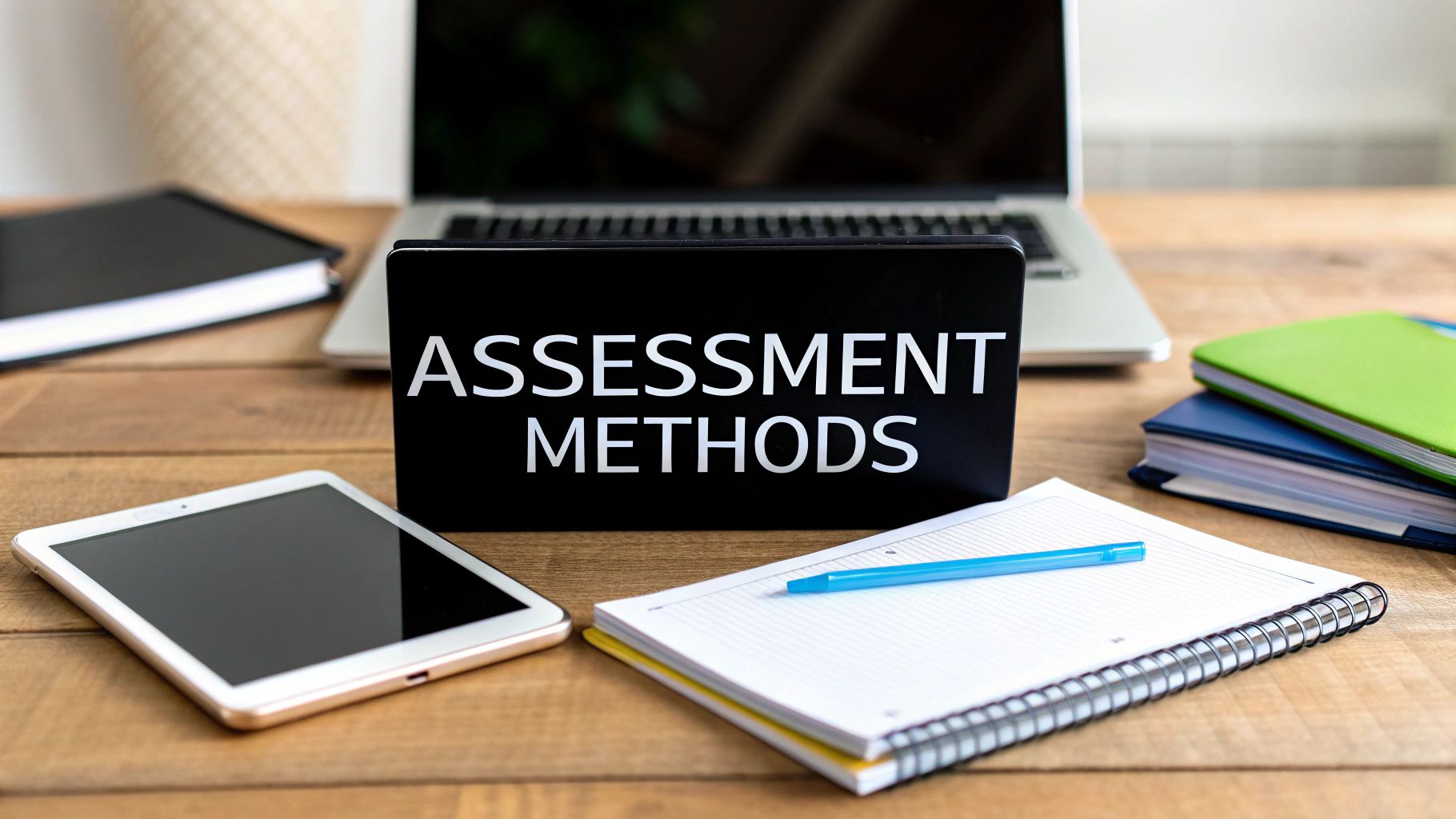When we talk about the best methods of assessment, it’s not about judging a child with a final score. It’s about understanding their unique learning journey, feeling their triumphs, and helping them through their struggles. It means moving beyond high-stakes testing to create a supportive, emotional connection between teacher and student, one that focuses on growth and building real, heartfelt confidence.
Ultimately, it’s about finding the right tool to see what a child truly knows and where they might need a gentle, guiding hand along the way.
Rethinking How We Measure Student Progress
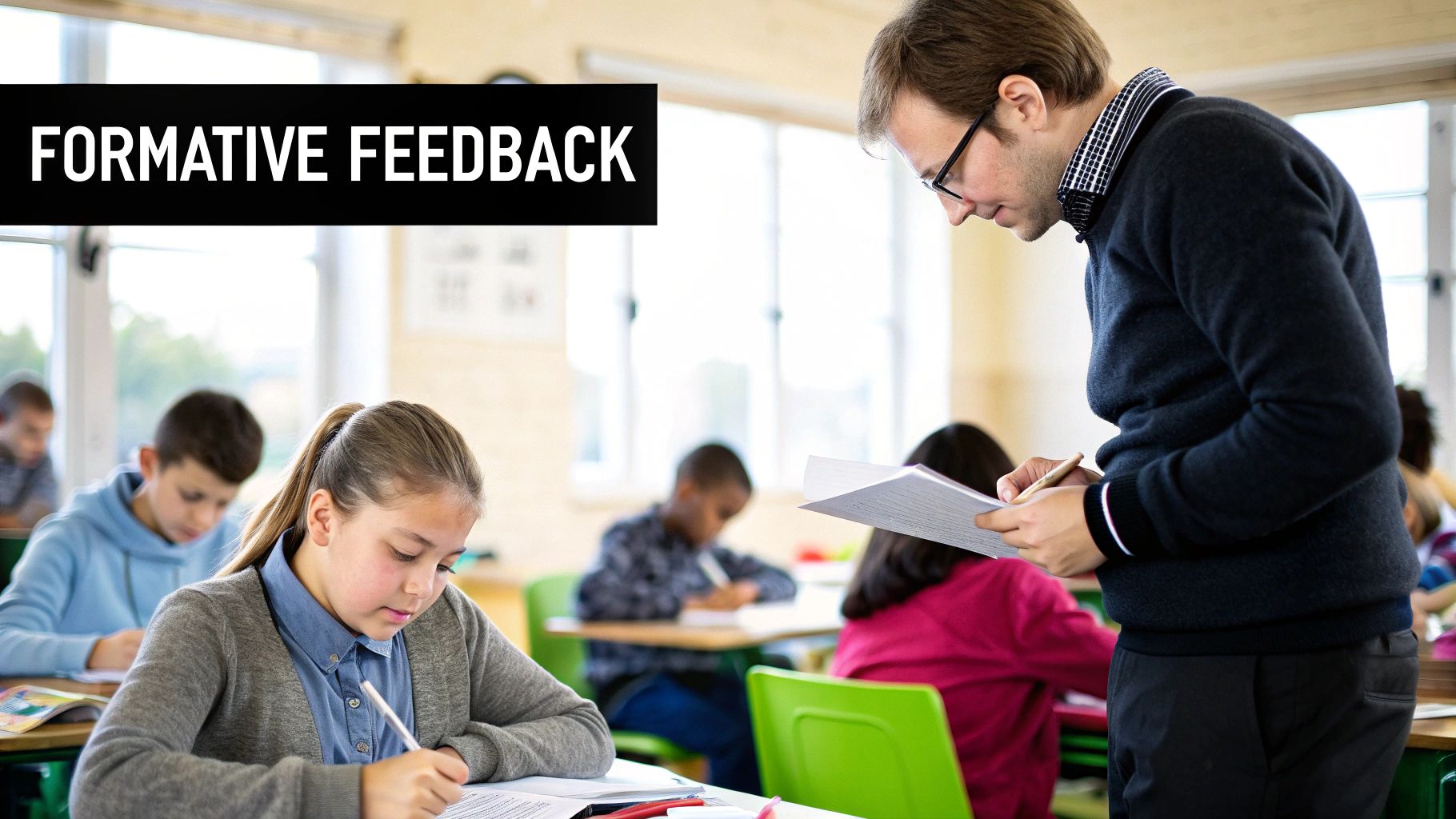
For many of us, the word "assessment" brings back a knot in our stomach—memories of a silent, intimidating exam hall. But what if we saw it differently? What if we viewed it not as a final, scary verdict, but as a compassionate roadmap—a guide that illuminates the path forward for every single child? This shift in perspective is right at the heart of modern, effective education.
This guide tackles a core concern for every parent and educator: how do we genuinely understand a student's progress without heaping on more anxiety? We'll explore different methods of assessment that put a child’s emotional wellbeing and intellectual curiosity at the very centre of the learning process.
Beyond the Red Pen
The traditional picture of assessment is often a test paper covered in red ink, highlighting every single mistake. Imagine a young child seeing their hard work returned, covered in marks that feel like shouting. This kind of feedback can make children feel defined by their errors, damaging their confidence and souring their relationship with learning. A more supportive and effective model reframes assessment as a collaborative, caring process.
Think of assessment not as a test, but as a conversation. It's a continuous, gentle dialogue that helps a child see their own strengths, pinpoint areas for growth, and feel that the learning plan is being adjusted to fit them, not the other way around.
This philosophy is especially vital in flexible learning environments. For parents exploring different educational paths, understanding these supportive strategies is key. You can discover more about how this works in practice within the framework of online home education in the UK.
What This Guide Will Explore
Our goal here is to give you practical, empathetic strategies that empower you to choose and use assessment methods that foster a genuine love of learning. We'll get into the specifics of different approaches, moving from ongoing, in-the-moment feedback to celebrating major milestones with joy.
Here’s a quick look at what you can expect to learn:
- Formative Assessment: How to use real-time feedback as a supportive 'coach' to guide a child as their understanding blossoms.
- Summative Assessment: Ways to turn final projects and tests into proud celebrations of knowledge and real, heartfelt achievement.
- Peer and Self-Assessment: Techniques that help a child build lifelong skills like self-reflection, critical thinking, and compassionate collaboration.
- Digital Tools: How technology like online portfolios can tell a richer, more personal story of a child's growth over time.
By embracing these varied methods, we can finally move away from a one-size-fits-all model. Instead, we can create an assessment culture that truly nurtures curiosity, builds resilience, and prepares every child for a bright and successful future.
Using Formative Assessment for Real-Time Feedback
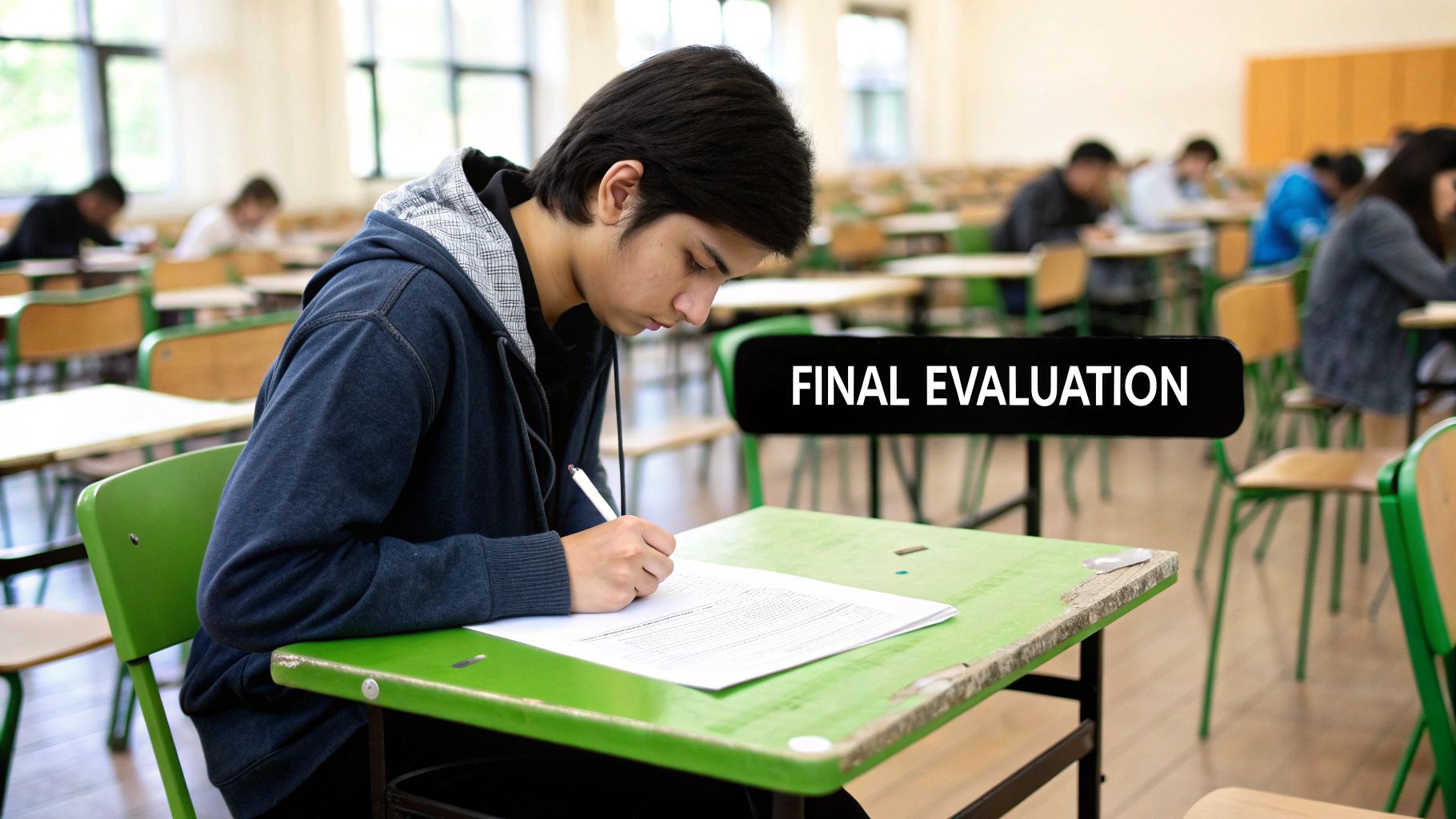
Think of a sports coach who offers constant, gentle guidance during practice, not a distant judge who only shows up to score the final match. That's the heart of formative assessment. It’s not about grades; it’s an ongoing, compassionate conversation between a teacher and a student, designed to build confidence and steer the learning journey as it unfolds.
This approach creates a low-stakes, safe space where a child learns that mistakes aren't failures but signposts for learning. For a child, that shift is powerful. It rewires their inner monologue from the fear of "I got it wrong" to the quiet confidence of "I'm figuring this out."
The real magic here is nurturing a resilient, growth-focused mindset. By concentrating on the process rather than just the final result, we teach children to see themselves as capable learners who can tackle challenges. It’s one of the most vital assessment methods for cultivating a genuine, lifelong love of learning.
What Formative Assessment Looks Like in Practice
Formative assessment isn't a single, big event. It’s a series of frequent, informal check-ins that give educators a real-time pulse on what a child understands. These aren’t tests to cram for; they are natural, woven into the fabric of the lesson itself.
For instance, a teacher might use:
- Interactive Polls: During a live online class on the solar system, a quick, anonymous poll can show whether a child grasps the difference between a planet and a star, without any fear of getting it "wrong" in front of their friends.
- Digital Exit Tickets: At the end of a lesson, a child might answer a simple prompt like, "What was the most exciting thing you learned today, and what still feels a bit fuzzy?" This gives the teacher immediate insight into their emotional and intellectual engagement.
- Guided Discussions: A gentle, guided chat allows a teacher to hear a child’s thought process out loud, celebrating their unique insights and gently correcting misconceptions on the spot.
These small, everyday interactions are gold dust for a teacher. They allow an educator to adapt their teaching instantly, giving a little extra help to a child who is stuck or offering a new challenge to one who is flying ahead.
Building Confidence in an Online Setting
In an online school, these assessment methods are more critical than ever. Without the physical cues of a traditional classroom, teachers depend on these tools to stay tuned in to each child’s academic progress and emotional wellbeing.
Formative assessment acts as a supportive bridge, ensuring that no child feels invisible or left behind in a virtual classroom. It’s about making learning a true partnership, built on trust and care.
Think about a student who is too shy to speak up in a live video lesson. A private chat message to the teacher asking, "I'm not sure I understand that part about fractions," is a perfect example of formative assessment in action. The teacher’s quick, personalised reply provides immediate support that can build that child’s confidence to participate more openly next time. It’s this nurturing approach that makes the learning experience feel safe and encouraging.
This focus on flexible, in-the-moment evaluation has gained significant ground in recent years. The suspension of formal assessments like SATs during the pandemic sped up the move towards more responsive practices. Formative assessments grew in popularity because they allow for real-time adjustments tailored to individual needs, reflecting a wider understanding in the UK that assessment should support personalised learning, not add to student stress. You can read more about this educational shift in England on junipereducation.org.
Practical Examples of Formative Tools
The beauty of formative assessment is its versatility. It can be as simple as a quick thumbs-up/thumbs-down check-in or as structured as a detailed review of a first draft.
Here are a few more powerful examples:
- Think-Pair-Share: A teacher poses a question. The child thinks about it alone, then joins a partner in a breakout room to discuss their ideas, and finally shares their combined thoughts with the whole class. This simple process validates their individual thoughts while building collaborative skills.
- Concept Maps: A student might draw a colourful concept map showing how different characters from a history lesson connect. This visual tool reveals their depth of understanding far more effectively than a multiple-choice quiz ever could, and it’s fun.
- Peer Feedback: With clear and kind guidelines, students can review one another’s work. This not only helps the child receiving the feedback but also deepens the reviewer’s own grasp of the subject.
Ultimately, every one of these assessment methods sends a clear and powerful message to the child: your learning process matters. It shows them that their progress is seen and supported every single day, not just judged at the end of a term.
Celebrating Milestones with Summative Assessment

If formative assessment is the ongoing, gentle conversation, then summative assessment is the proud, shining moment at the end of a learning chapter. Think of it as the final performance, the end-of-term exhibition, or the big project that showcases everything a child has learned and mastered. It’s a snapshot in time, capturing a student's knowledge at a key milestone.
For many children, these big moments can feel like high-pressure events. The trick is to reframe them, shifting the emotional focus from a stressful test to a proud demonstration of achievement. It’s a chance for a student to step back and feel that amazing rush of, “Look how far I’ve come!”
When we look at summative assessment through this lens, it transforms into a positive and powerful part of the educational journey. It becomes less about the score and more about validating a child's hard work, growth, and deep understanding.
More Than Just a Test
Traditional exams often only test a child's ability to recall information under pressure, which isn't always the best measure of deep understanding. In a child-centred online school, summative assessments can be creative, engaging, and far more revealing of a student's true capabilities.
These kinds of assessments allow children to apply what they've learned in ways that feel meaningful and personal to them. They test critical thinking, problem-solving, and creativity—skills that are infinitely more valuable than just memorising dates or formulas.
The goal of a summative assessment should be to give a child a stage to perform on, not just a hoop to jump through. It's their opportunity to synthesise what they've learned and present it with pride.
By offering a variety of summative tasks, we can cater to different learning styles and give every child a chance to shine. It’s an acknowledgement that intelligence and understanding can be shown in many different, wonderful ways.
Practical and Inspiring Summative Examples
Let's move beyond the standard multiple-choice test. Here are a few examples of summative assessments that truly empower a child:
- Final Creative Projects: Instead of an exam on Shakespeare, a child could direct a scene using their toys, design costumes for the characters on a tablet, or write a modern-day text message exchange between Romeo and Juliet. This shows a profound grasp of character, theme, and story in a way that feels like play.
- Open-Book Online Exams: These assessments test application, not just memory. With access to their notes and texts, a child must analyse, evaluate, and synthesise information to build a compelling argument, feeling resourceful rather than stressed.
- Investigative Reports: For a science unit on plants, a child could grow their own bean plant at home over several weeks. They would then present their findings in a diary with photos, data, and their own conclusions, feeling like a real scientist.
This approach is especially valuable for older students preparing for key qualifications, as it builds the skills they'll need for higher education and their future careers. To see how these principles apply in a formal context, you can explore our guide on mock GCSE exams.
Ensuring Fairness and Credibility
One of the cornerstones of any good summative assessment is making sure the results are credible and fairly reflect what a student has learned. This demands clear standards and a transparent marking process so a child feels their work has been seen and valued properly.
This principle of integrity is taken very seriously in the UK, even at a national level. For instance, the Statistics and Registration Service Act 2007 established a robust framework to guarantee the quality and trustworthiness of official data, ensuring all outputs meet high standards. You can read more about the work done by the UK Statistics Authority to enhance the impact of assessment.
This same commitment to quality belongs in the classroom. When a child receives a grade on a final project, they deserve to know it was marked fairly against clear criteria. This is how we build trust in the assessment process and help students see real value in their final evaluations.
Choosing the Right Assessment for Your Child
Deciding on the best way to assess your child’s learning isn’t about picking one “winner” over another. Instead, think of it like building a personalised toolkit for their education. The aim is to create a flexible, responsive strategy that keeps their needs, their confidence, and their genuine understanding at the very centre of everything.
A powerful assessment strategy is always a blend. It’s about knowing when to use the right tool for the right job to get a complete, compassionate picture of your child’s progress. This means mixing ongoing, gentle support with joyful milestone celebrations.
This balanced approach is a cornerstone of modern education, especially in settings that put individual growth first. For parents exploring different educational paths, our detailed guide on how to homeschool in the UK offers more insights into creating a supportive learning environment at home.
The Right Tool for the Right Job
So, how do you choose? It all comes down to what you need to understand about your child’s learning at that specific moment. Are you just checking in on a brand-new concept, or are you ready to celebrate their mastery of a whole topic?
Here are a few scenarios to make it clearer for your child:
- The Daily Check-in: Your child has just finished a maths lesson on fractions. A quick, fun online quiz (formative) with instant, positive feedback is the perfect tool to see if the core idea has landed, without any pressure.
- Developing a Skill: A student is learning to write persuasive essays. Gently reviewing their first draft with them and offering specific, kind pointers for improvement (formative) is far more helpful than just slapping a final grade on it.
- The End-of-Unit Project: After a six-week history topic on Ancient Rome, a project where your child builds a model of the Colosseum from Lego and writes a report about it (summative) is a fantastic way for them to show off their deep understanding with pride.
The most effective approach uses both. It combines the 'coach' (formative) for daily practice and the 'photograph' (summative) to capture those proud moments of achievement.
This blend ensures your child feels supported every single day while also having clear, exciting goals to work towards. It avoids the anxiety of constant testing but still provides clear benchmarks of their progress.
Formative vs Summative Assessment: When to Use Each Method
To make this even clearer, let's look at these two core assessment methods side-by-side. Understanding their distinct purposes helps clarify when each one is most valuable on your child's journey. Think of one as a coach guiding from the sidelines and the other as a snapshot capturing a finished performance.
| Aspect | Formative Assessment (The Learning 'Coach') | Summative Assessment (The Learning 'Photograph') |
|---|---|---|
| Purpose | To guide and improve learning as it happens. It's all about gentle feedback and adjustment. | To measure what has been learned at the end of a unit or term. It evaluates mastery and celebrates achievement. |
| Timing | Ongoing and frequent. Happens daily or weekly throughout the learning process. | Infrequent. Happens at key milestones, like the end of a term or year. |
| Impact on Child | Builds confidence and reduces anxiety. Mistakes are seen as beautiful learning opportunities. | Provides a sense of accomplishment and closure. Celebrates their hard work and success. |
Each method has a role to play in building a complete, loving picture of your child's abilities and confidence.
Ultimately, choosing the right assessment is an act of empathy. It’s about asking, "What does my child need right now to feel successful and understood?" By using a thoughtful mix of assessment methods, we can provide an educational experience that is not only effective but also deeply nurturing.
Building Lifelong Skills with Peer and Self-Assessment
A truly meaningful education does more than just fill a child’s head with facts; it equips them with essential skills for life. And while a teacher’s feedback is vital, some of the most powerful learning happens when we teach students to turn the lens inward. This is where peer and self-assessment come in, empowering children to become active, confident participants in their own educational journey.
Imagine helping a child become the proud ‘captain of their own learning ship’. That’s the real impact of self-reflection. It’s about giving them the tools to look at their own work with kind eyes, honestly identify its strengths, and pinpoint exactly where they can improve. This fosters a sense of ownership that is deeply motivating and builds skills that will serve them for a lifetime.
The Power of Looking Inward
Self-assessment isn't about a child being hard on themselves. It’s about asking them to step into the role of a constructive, friendly reviewer of their own work. The goal is to develop metacognition—the ability to think about one's own thinking. This is, without a doubt, one of the most crucial skills for becoming an independent, lifelong learner.
When guided by clear and simple rubrics, a child learns to ask themselves powerful questions:
- "Did I really explain my idea clearly here so my friend would understand?"
- "What is one fun thing I could do to make this even better?"
- "Am I proud of the heart I put into this piece of work?"
This simple, reflective practice is incredibly empowering. It shifts the dynamic from passively waiting for a teacher's verdict to actively taking control of their own growth. The child learns that their own opinion of their work matters, giving them a real voice and a stake in their education.
This infographic breaks down how different assessment methods fit into the learning journey.
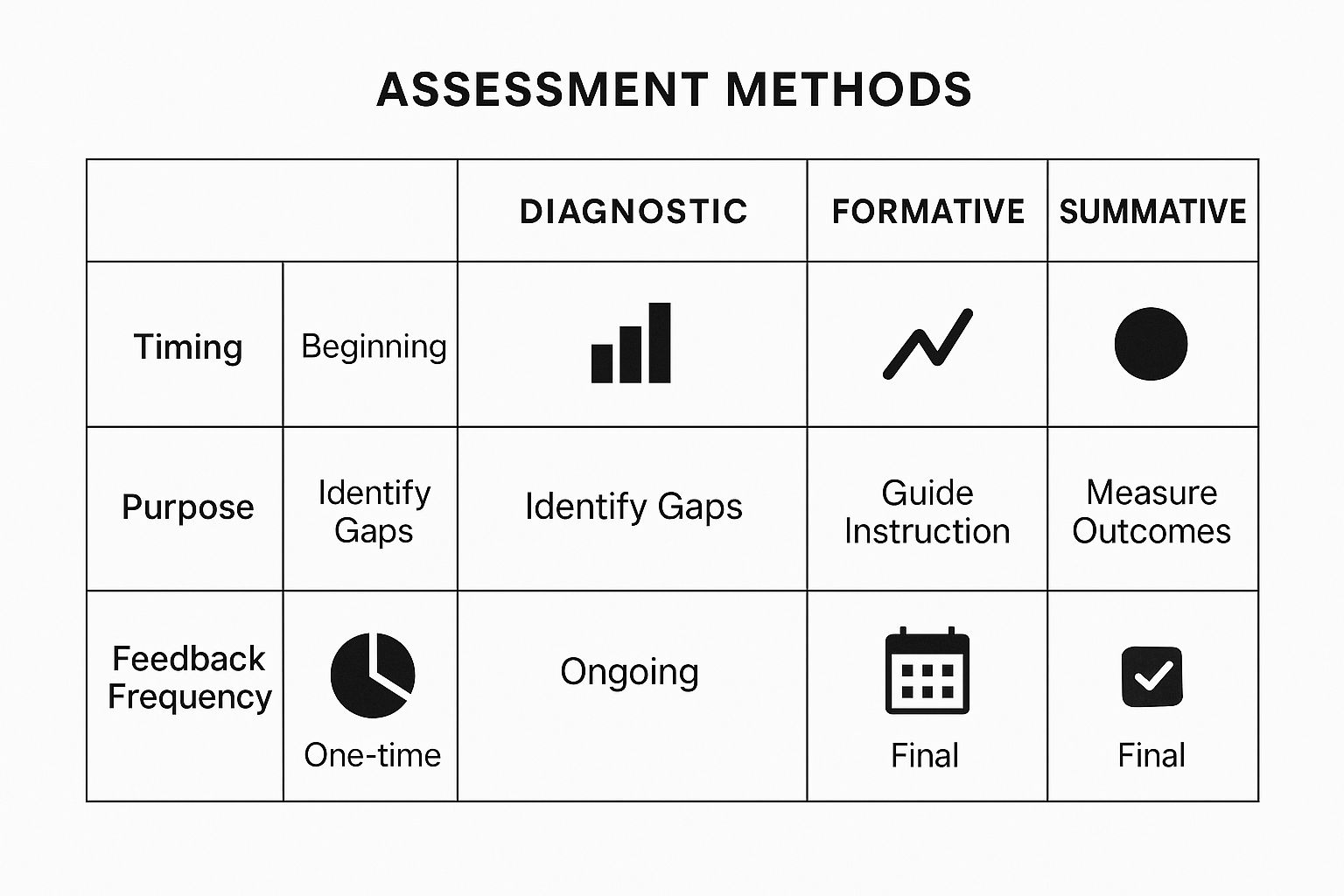
As you can see, assessment isn't a single event. It’s a continuous, caring cycle where we check for understanding at the start, guide learning as it happens, and measure the final outcomes with pride.
Learning Through a Friend's Eyes
Peer assessment, when managed with care and kindness, is another fantastic tool. It teaches children invaluable skills in collaboration, communication, and empathy. The aim isn’t for students to "grade" each other, but to offer constructive, helpful feedback as friends.
A common worry is fairness, which is why structure is absolutely key, especially in an online school. Teachers can provide sentence starters to guide the feedback, ensuring it stays positive and genuinely helpful.
For example, instead of a child saying, "This is confusing," they might be guided to say, "I love this part! Could you explain this other bit a bit more? I got a bit lost here." This simple change transforms a blunt critique into a supportive conversation.
This process does more than just improve the work being reviewed. The child giving the feedback also deepens their own understanding by analysing their peer's work against the success criteria. It’s a win-win for their confidence and their learning.
This drive towards more authentic and varied assessment is being seen right across the UK education system. In higher education, for instance, there's a growing focus on using diverse assessments like project-based tasks and real-world simulations to better suit different student abilities. If you’d like to know more, you can explore recent guidance on UK assessment practices. The trend reflects a wider commitment to making evaluation more meaningful for every child.
Putting It Into Practice Online
In an online school, integrating peer and self-assessment is straightforward. A student might use a digital checklist with smiley faces to review their own essay draft before they submit it. In a group project, students in a breakout room could use a shared rubric to give positive feedback on each other's contributions before proudly presenting to the whole class.
Ultimately, these methods of assessment prepare children for the future. In any career, the ability to reflect on your own performance and to give and receive feedback graciously is non-negotiable. By building these skills early, in a safe and supportive way, we aren't just creating better students; we are nurturing more reflective, collaborative, and confident human beings.
How Digital Portfolios Tell a Richer Learning Story
Technology has opened the door to some wonderfully personal and insightful ways of understanding a child’s progress. One of the most compelling is the digital portfolio. Think of it as a living, breathing scrapbook of learning, carefully put together by a child to show off their proudest work and track their amazing journey over time.
Instead of a single test score, which is just a cold snapshot, a portfolio tells a rich and detailed story of a child’s growth. It captures everything from the messy first drafts to the polished final pieces, showing the process of learning, not just the end result. It puts the child in the director’s chair of their own educational story, letting them take real pride in their progress.
A Gallery of Growth and Achievement
A portfolio is so much more than just a folder of files; it’s a dynamic, personal space where a child's learning becomes visible. It offers a panoramic view of their abilities, far beyond what a traditional exam could ever hope to measure. The emotional benefit is huge—it validates effort, celebrates perseverance, and builds a deep, lasting sense of accomplishment.
Imagine a child proudly sharing their digital portfolio:
- For Science: They could upload videos of a series of experiments they did in the kitchen, photos of their results, and a colourful lab report. This demonstrates their grasp of the scientific method, critical thinking, and communication skills all at once, making them feel like a real inventor.
- For Creative Writing: A portfolio could hold a collection of poems, short stories, and reflective journal entries. It might even include audio recordings of them reading their own work aloud, adding a powerful layer of personal expression and confidence.
- For Coding: A student could share different versions of a game they built—from the initial buggy code to the final, playable version—along with a screen recording of it in action.
This method allows a child to show, not just tell, what they can do. It honours the reality that learning is often a winding, magical path, full of discovery, revision, and "aha!" moments.
Placing the Child at the Centre
One of the most beautiful things about using portfolios for assessment is how it places the child’s voice and choice right at the heart of the process. Students aren't passive recipients of a grade; they are active curators of their own work. This builds crucial self-regulation skills as they learn to reflect on their learning and select pieces that best represent their growth.
A portfolio asks the child, “What work makes your heart feel proud?” This simple question shifts the focus from pleasing the teacher to developing internal standards of quality and taking ownership of their achievements.
For a child who feels that familiar knot of anxiety with timed tests, a portfolio offers a much less stressful, more authentic way to demonstrate their knowledge. It gives them the freedom to learn at their own pace and present their understanding in a format that plays to their strengths. For instance, a child with a learning disability can feel more relaxed and connected with peers and teachers when they have the time to carefully craft their entries.
Making Portfolios Work in an Online School
Digital portfolios are perfectly suited for online learning. Using simple, accessible blog-style platforms, students can easily upload and organise their work. These tools often allow for comments, turning the portfolio into a space for supportive dialogue between the student, teacher, and even peers.
To ensure it works well, it’s vital to provide clear, kind guidelines. For example, a simple rubric with pictures can help a child understand what makes a strong entry and guide their self-reflection. This structure helps them regulate their own learning without taking away their creative freedom.
Ultimately, a digital portfolio is one of the most powerful assessment methods for telling a complete story. It captures a child’s triumphs, their "aha!" moments, and their steady progress, creating a meaningful record that builds confidence for the journey ahead.
Your Questions About Modern Assessment, Answered
Stepping into the world of modern assessment can feel like a mix of excitement and uncertainty. It’s completely natural for parents and educators to have questions. After all, we all share the same goal: to see every child flourish, and that means being sure we’re using the right tools to support them, both academically and emotionally.
We've gathered some of the most common questions we hear from families just like yours. Our answers are here to offer clarity and reassurance, always keeping your child’s wellbeing at the heart of the conversation.
How Can I Help My Child Prepare Without Causing Anxiety?
The real secret is to shift the focus away from "preparation" as a one-off, scary event. Instead of stressful, last-minute cramming for a big exam, think in terms of consistent, low-stakes practice that happens all term long. This approach builds confidence bit by bit and helps both you and the teacher spot any learning wobbles early on—long before they can grow into a source of stress.
Always frame a summative assessment as a chance for your child to ‘show what you know,’ not a high-pressure event that defines their worth. Celebrate their effort and progress along the way, not just the final result. A balanced study schedule, lots of rest, and big hugs are just as important as revision.
Are Peer and Self-Assessment Really Fair?
Absolutely. When they’re set up with clear, kind guidelines, these are incredibly powerful and fair tools. The aim isn't for children to slap a grade on each other's work. It’s about teaching them how to give and receive constructive feedback that helps everyone grow. The teacher’s role here is crucial in guiding the process and keeping it safe.
For instance, a teacher might provide simple rubrics or sentence starters like "I really liked how you…" and "Maybe next time you could try…" to ensure all feedback stays helpful and positive. These methods of assessment are designed to build critical thinking and teamwork, and they work alongside—not in place of—the teacher's professional judgement.
In an Online School, How Do I Know if Assessment Is Effective?
There are two key things to look for: variety and clear, warm communication. A truly effective online school won’t rely on just one type of test. Instead, you’ll see a rich blend of assessment methods, from quick understanding checks during live lessons to creative projects and collaborative group tasks. You should never feel like your child’s entire progress is boiled down to a single, cold grade.
Even more importantly, you should be getting regular, transparent updates from the teacher that talk about your child as a whole person. Effective assessment means you have a complete, well-rounded picture of your child’s strengths and areas for growth, backed up by lots of different examples of their wonderful work.
At Queens Online School, we believe the best methods of assessment are the ones that empower students and build their confidence for the journey ahead. Our teachers use a compassionate, blended approach to understand each child's unique learning story. To find out more about our supportive educational environment, visit us at https://queensonlineschool.com/.
